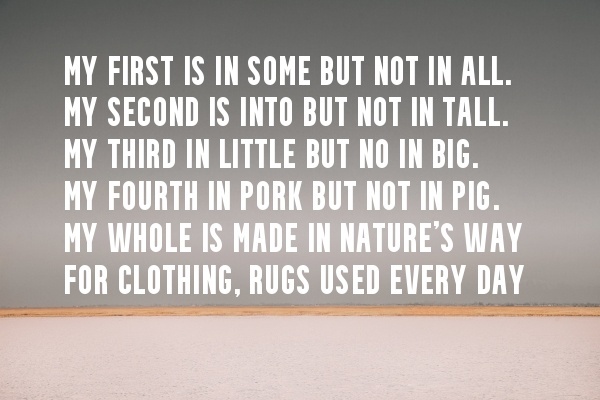Puzzles and riddles have always had a unique way of pulling us in. They might appear simple at first glance, but as you dive deeper, they test your wit, logic, and attention to detail. Today, we’re unraveling a classic word riddle:

“My first is in some but not in all.
My second is into but not in tall.
My third in little but not in big.
My fourth in pork but not in pig.
My whole is made in nature’s way.
For clothing, rugs used every day.”
Common Mistakes When Solving Riddles Like This
It’s no secret—riddles often frustrate people. Why? Because they demand a level of attention that we don’t always give. Here are some common pitfalls that trip up even the cleverest minds:
- Overthinking the Problem
One of the most frequent mistakes is trying to make the riddle more complicated than it really is. Sometimes, the answer is staring you in the face, but your mind is searching for something grander. For example, instead of focusing on the specific letters mentioned in the clues, people might try to form entire words in their heads, leading them astray. - Ignoring Key Details
In riddles, every word is intentional. Words like “some,” “little,” and “pork” aren’t random—they’re carefully chosen to guide you. Skipping over these seemingly minor details often leads to incorrect answers. - Jumping to Conclusions
Rushing to answer the riddle without fully analyzing each part is another common error. Many people hear the first few lines, make an assumption, and lock in their answer—only to realize they’ve missed crucial parts of the puzzle. - Not Breaking It Down Step by Step
Riddles are like puzzles; they need to be solved piece by piece. Trying to tackle the entire thing at once can overwhelm you. Instead, taking a methodical approach will help you uncover the answer more effectively.
Step-by-Step Guide to Solve the Riddle
Ready to solve the riddle? Let’s break it down systematically and uncover the answer one line at a time.
Step 1: Analyze the First Clue
“My first is in some but not in all.”
The first clue tells us that the first letter of the word is present in the word “some” but not in the word “all.” The letter ‘S’ fits perfectly—it’s in “some” but not in “all.”
Step 2: Examine the Second Clue
“My second is into but not in tall.”
The second letter of the word is in “into” but not in “tall.” If we look carefully, the letter ‘I’ is in “into,” but it doesn’t appear in “tall.”
Step 3: Decode the Third Clue
“My third in little but not in big.”
For the third letter, we need a letter that appears in “little” but not in “big.” The letter ‘L’ stands out here—it’s in “little” but missing from “big.”
Step 4: Solve the Fourth Clue
“My fourth in pork but not in pig.”
The fourth letter must be in “pork” but not in “pig.” After some thought, the letter ‘K’ is the only option—it’s in “pork” but not in “pig.”
Step 5: Combine the Letters
Now that we’ve identified the letters:
- S from the first clue
- I from the second clue
- L from the third clue
- K from the fourth clue
When we put them together, they spell the word SILK.
Step 6: Validate the Final Clue

“My whole is made in nature’s way. For clothing, rugs used every day.”
Silk is a natural fiber created by silkworms, and it’s widely used in making clothing, rugs, and other textiles. This final clue confirms that our answer is correct.
Why Attention to Detail Is Key
What makes this riddle so engaging is the importance of details. Each line provides a small but vital piece of information, and skipping even one of them would lead to the wrong answer. Riddles like this teach us to slow down and focus on the specifics, which is a skill that translates well into everyday problem-solving.
Think about it—how often do we overlook small details in our day-to-day lives? Whether it’s reading an email, following instructions, or even solving a disagreement, paying attention to the finer points can make all the difference.
Share Your Answer and Join the Conversation
Now that we’ve solved the riddle together, it’s your turn! Did you figure out the answer on your own, or did you need some help? Let us know in the comments below. And if you’ve got a friend who loves puzzles, challenge them to solve this one too. Sharing riddles is a great way to spark conversations and keep our minds sharp.
Conclusion: The Joy of Solving Riddles
Riddles like this one are more than just fun—they’re a fantastic way to exercise your brain and improve your logical thinking. They teach us to pay attention to details, think creatively, and approach problems methodically. Plus, there’s nothing quite as satisfying as cracking a tricky puzzle!
So, the next time you come across a riddle, don’t shy away. Dive in, take it step by step, and enjoy the challenge. Who knows—you might even come up with your own riddle to stump your friends.
And if you enjoyed this one, there are plenty more out there waiting for you. Keep solving, keep sharing, and most importantly, keep having fun. Happy puzzling!


